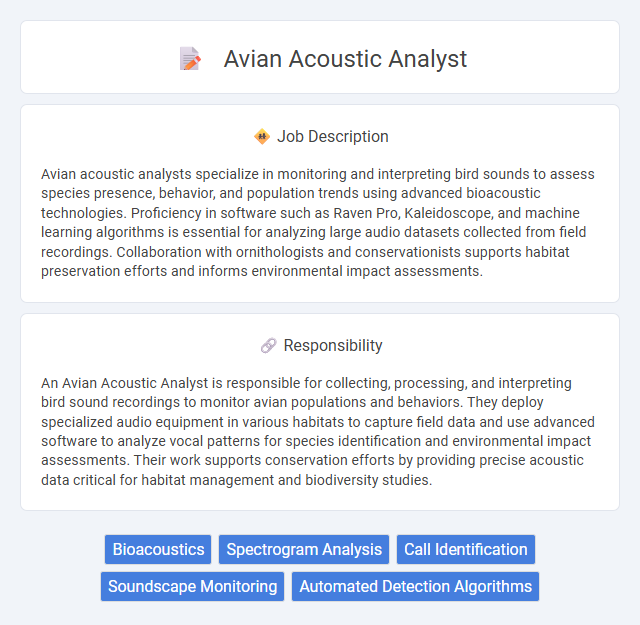
Avian acoustic analysts specialize in monitoring and interpreting bird sounds to assess species presence, behavior, and population trends using advanced bioacoustic technologies. Proficiency in software such as Raven Pro, Kaleidoscope, and machine learning algorithms is essential for analyzing large audio datasets collected from field recordings. Collaboration with ornithologists and conservationists supports habitat preservation efforts and informs environmental impact assessments.
Individuals with strong auditory attention and analytical skills are likely suitable for the role of an Avian Acoustic Analyst, as the job involves discerning subtle bird calls and patterns. Candidates who may struggle with long periods of focused listening or have limited interest in wildlife biology might find this job challenging. The position probably attracts those passionate about ornithology and data interpretation, enhancing their overall job satisfaction and effectiveness.
Qualification
An Avian Acoustic Analyst requires expertise in bioacoustics, ornithology, and environmental science, with proficiency in using specialized software for audio analysis, such as Raven Pro or Kaleidoscope. Advanced degrees in biology, ecology, or related fields, alongside experience in field data collection and sound identification, are crucial for accurate species monitoring and habitat assessment. Strong analytical skills, attention to detail, and familiarity with acoustic survey protocols enhance the ability to interpret avian calls and support conservation efforts effectively.
Responsibility
An Avian Acoustic Analyst is responsible for collecting, processing, and interpreting bird sound recordings to monitor avian populations and behaviors. They deploy specialized audio equipment in various habitats to capture field data and use advanced software to analyze vocal patterns for species identification and environmental impact assessments. Their work supports conservation efforts by providing precise acoustic data critical for habitat management and biodiversity studies.
Benefit
Avian acoustic analysts likely gain valuable experience in ecological monitoring by interpreting bird vocalizations to assess species presence and behavior, which could enhance conservation strategies. This role may offer opportunities to develop expertise in bioacoustics technology and data analysis, increasing employability in environmental research fields. Working in diverse ecosystems might also provide enriching exposure to wildlife, potentially benefiting personal and professional growth.
Challenge
The role of an Avian Acoustic Analyst likely presents challenges in accurately interpreting complex bird vocalizations amid diverse environmental noise. Handling large datasets of audio recordings may require advanced analytical skills and specialized software proficiency. There is a probability that the analyst must adapt to variable field conditions and evolving research methodologies to maintain data reliability.
Career Advancement
An Avian Acoustic Analyst leverages expertise in bioacoustics and advanced audio analysis software to monitor bird populations and assess environmental impacts. Career advancement opportunities include progressing to senior ecological consultant roles, leading research projects, or transitioning into conservation management and policy advisory positions. Mastery of machine learning techniques and geographic information systems (GIS) can significantly enhance prospects for leadership and specialized roles within environmental agencies and research institutions.
Key Terms
Bioacoustics
Avian acoustic analysts specialize in bioacoustics, utilizing advanced audio recording technologies and software to monitor and study bird vocalizations for conservation and behavioral research. They analyze sound patterns to identify species, track migration routes, and assess habitat health, contributing essential data for ecological management. Proficiency in spectrogram interpretation and experience with automated detection algorithms are critical skills in this role.
Spectrogram Analysis
Avian acoustic analysts specialize in interpreting spectrograms to identify bird species and monitor their behaviors through sound patterns. Proficiency in spectrogram analysis involves recognizing frequency ranges, temporal patterns, and unique vocal signatures essential for accurate species classification. This expertise supports conservation efforts by enabling efficient detection of rare or elusive birds in diverse habitats.
Call Identification
Avian acoustic analysts specialize in identifying bird species through their vocalizations using advanced audio processing software and machine learning algorithms. Call identification involves analyzing frequency, duration, and pattern variations to accurately distinguish between similar bird calls. Expertise in bioacoustics and field recording techniques enhances the precision of monitoring avian populations and supporting conservation efforts.
Soundscape Monitoring
Avian acoustic analysts specialize in soundscape monitoring to study bird populations and their habitats through audio recordings. They utilize bioacoustic software to detect, identify, and quantify avian calls, enabling continuous wildlife assessment in various ecosystems. Their work supports conservation efforts by providing critical data on species distribution, behavior, and environmental changes.
Automated Detection Algorithms
Avian acoustic analysts specialize in developing and refining automated detection algorithms to identify bird species from audio recordings with high accuracy. These algorithms utilize machine learning techniques and large datasets of bird calls to enhance the detection and classification process in diverse and noisy environments. Expertise in signal processing and bioacoustics is essential for optimizing algorithm performance and enabling large-scale ecological monitoring.
 kuljobs.com
kuljobs.com